Brand guides
Authenticating adidas kits
This guide breaks down the essential elements of an authentic adidas kit, from material choices to design precision. You'll also learn how to spot common red flags in fake shirts and get practical advice for verifying authenticity, whether you're browsing in a shop or buying secondhand online.
The product code label
One of the most reliable ways to begin authenticating an adidas kit is by checking the product code, usually found on a small label typically sewn into the neck/shoulder area. Older shirts will have this label sewn into the left side of the shirt. This labeling system was introduced in the early 2000s, so kits produced before that period may not feature a product code label at all, which is important to consider when assessing vintage items.
Early label versions
Although this label has remained largely consistent since its introduction, earlier versions from around 1999 to 2002 may appear slightly different in format. They still contain the same essential information, but the layout or styling might vary. Keep in mind that this alone is not a sign the kit is fake, it’s just part of the evolution of Adidas labeling.
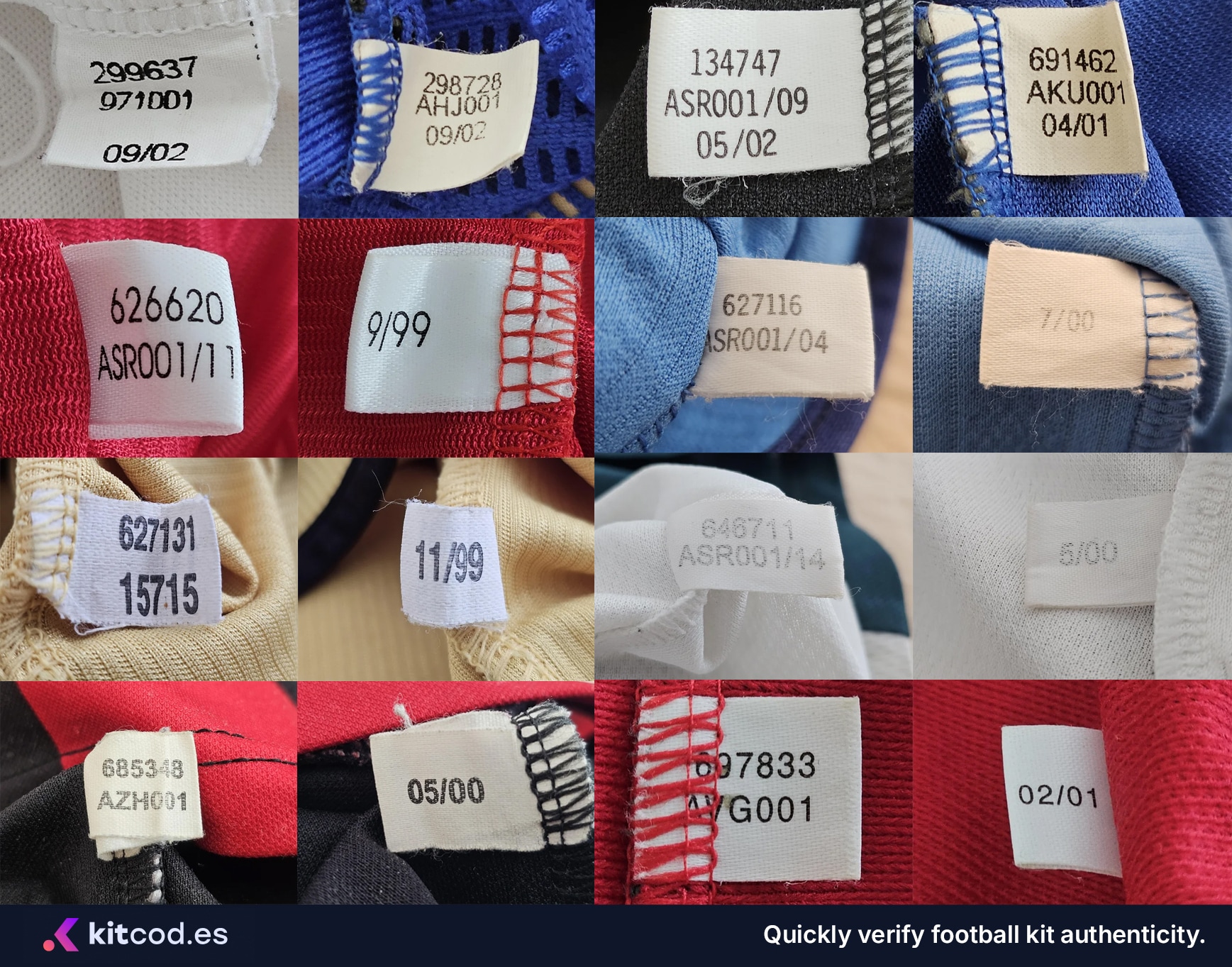
The product code
Adidas product codes are a good starting point when verifying the authenticity of a football kit. The product codes found on the little label are typically six-character alphanumeric strings (e.g. IS7462). On more recent shirts this code typically consist of 1 or 2 letters and 4 or 5 numbers, but on older kits a code consisting of 6 numbers is also common.
While these codes can help confirm that a kit's design exists and matches what it claims to be, they aren't foolproof. For that reason, adidas product codes are best used in combination with other indicators like stitching quality, print accuracy, and label details.

Using the shirts above, we can verify the product codes using kitcod.es. The fake shirt returns a result for a Mexico 2018 kit, while the shirt being sold is presented as a Bayern München kit, a clear mismatch. In contrast, the real kit yields a correct match for the Ajax Amsterdam 2013 away shirt.
Right code, wrong kit
Counterfeit kits often reuse real product codes to appear more convincing. For example, the Columbia 2018 Home kit uses the code CW1526. That code is valid, but only for that specific kit. If you see the same code on a different team's kit, it's almost certainly fake. A matching code doesn't always guarantee authenticity, but a mismatched one is a strong red flag.
The production code
The small product code label found inside adidas kits does more than just display the product code, it also provides clues about when the shirt was produced. Adidas includes a season code on this label, which helps determine the production timeframe. Typically, the number on the top line of the label represents the month and year of manufacture. For example, a label of 02/10 would indicate the kit was produced in February of 2010. This is especially helpful when checking whether a shirt's production date aligns with its claimed season. Counterfeit shirts often reuse the same label across different kits, which can result in inconsistencies or illogical combinations.

The bottom line of the label tends to be generic and appears on many different items. While it might indicate the factory or production location, its exact meaning remains unclear due to a lack of verifiable information.
The QR-code
This label, found on the back of the product code label, features a Data Matrix code, a type of 2D barcode used primarily for internal logistics and product tracking rather than consumer interaction. It encodes detailed information such as the product's style code, manufacturing batch, factory origin, and size, enabling adidas and its distribution partners to efficiently manage inventory, authenticate items, and streamline supply chain processes. While it resembles a QR code, the Data Matrix is optimized for compact spaces and high-speed scanning in warehouses and retail environments, and its data is typically only readable by specialized systems used by adidas and authorized resellers.
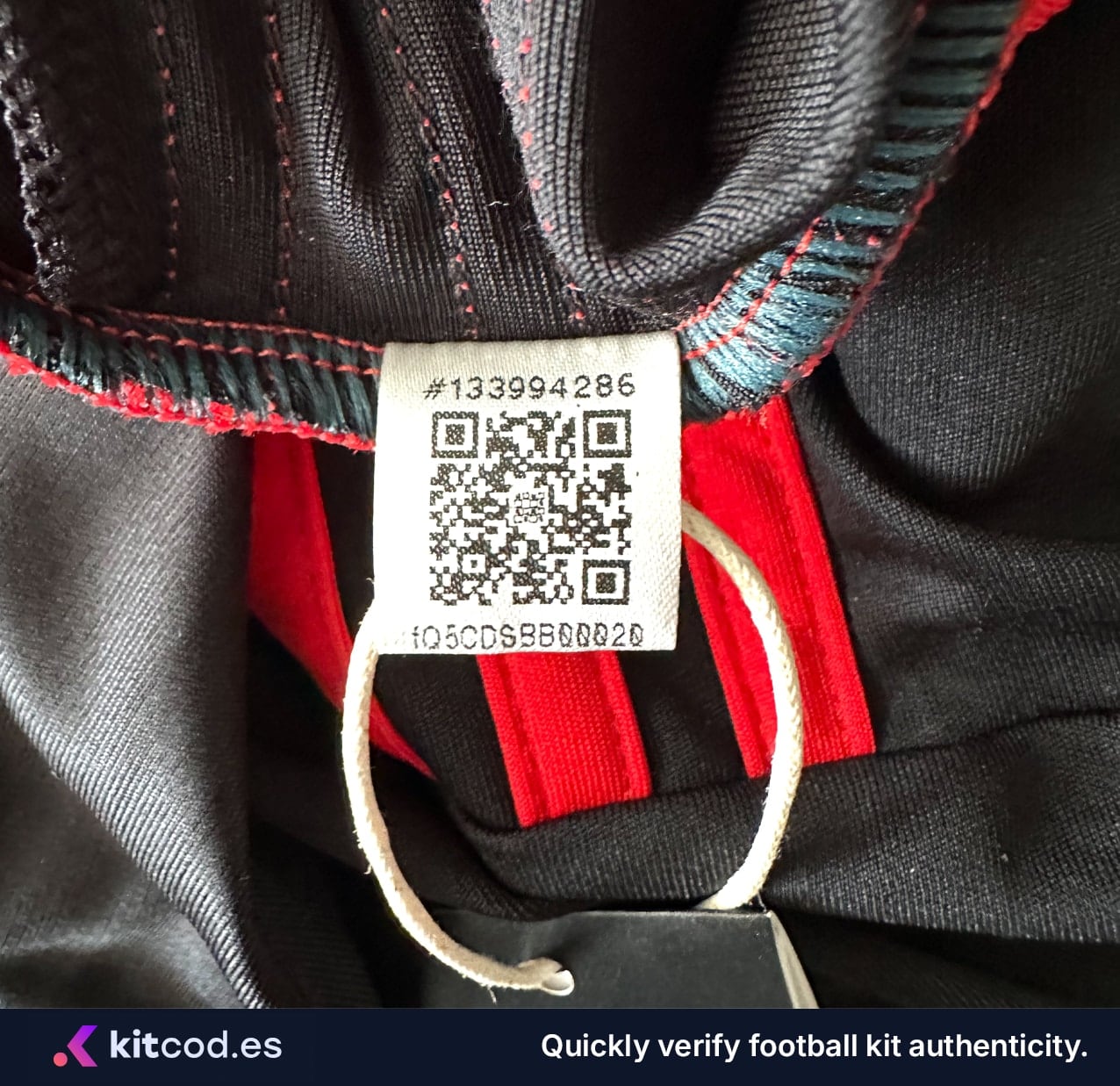
Template kits
When you see two product codes on an adidas kit swing tag, it usually means the shirt is a custom design based on a standard template. This setup is common for smaller clubs, limited editions, or one-off runs. One code refers to the base template, while the other represents the customized version.
In these cases, the inner label typically shows the template code, giving insight into the shirt's design foundation.

Sample kits
When authenticating adidas kits through product codes, it's important to understand that sample shirts may not follow the standard format used on retail or player-issued kits. Typically, for adidas, there are labels that clearly indicate that the shirt is actually a sample. These deviations don't necessarily indicate a fake, but rather they reflect that the kit was produced outside the normal retail cycle, often for marketing, review, or internal use. However, because of their irregular nature, sample kits should always be examined more closely, with extra attention to stitching, crests, materials, and label quality.
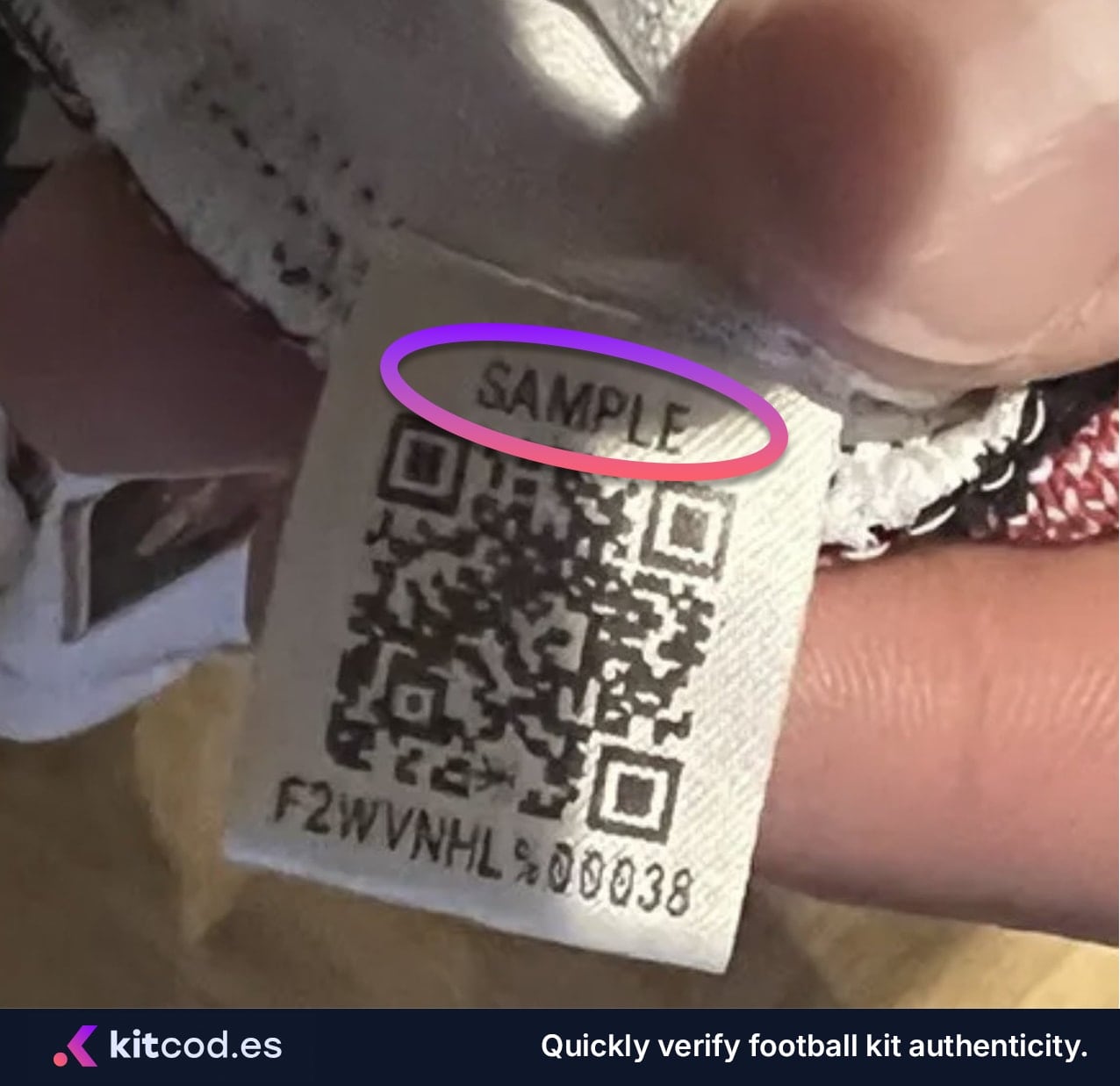
The swing tags
A swing tag is the detachable cardboard tag typically attached to a new kit, usually hanging from the sleeve or neck area by a plastic barb or twine. It contains key product information like the size, barcode, product code, and pricing. In the world of football kits, swing tags are important for collectors, as they can help verify authenticity and confirm the kit is unworn or in original retail condition.
Placement
On most genuine adidas football kits, the swing tag is usually attached to the neck label. While the neck is the standard location for modern kits, there are exceptions. On older shirts, especially those made before 2010, the swing tag might be attached to the sleeve seam or even the bottom of the shirt. These alternate placements aren't necessarily a red flag, but should match the style and age of the shirt to be considered consistent.
Design
Adidas swing tags are typically black. These tags include a removable sticker that displays key information such as the product code and sizing. One important detail to watch for is that authentic tags typically use a real, physical sticker instead of a printed-on label.
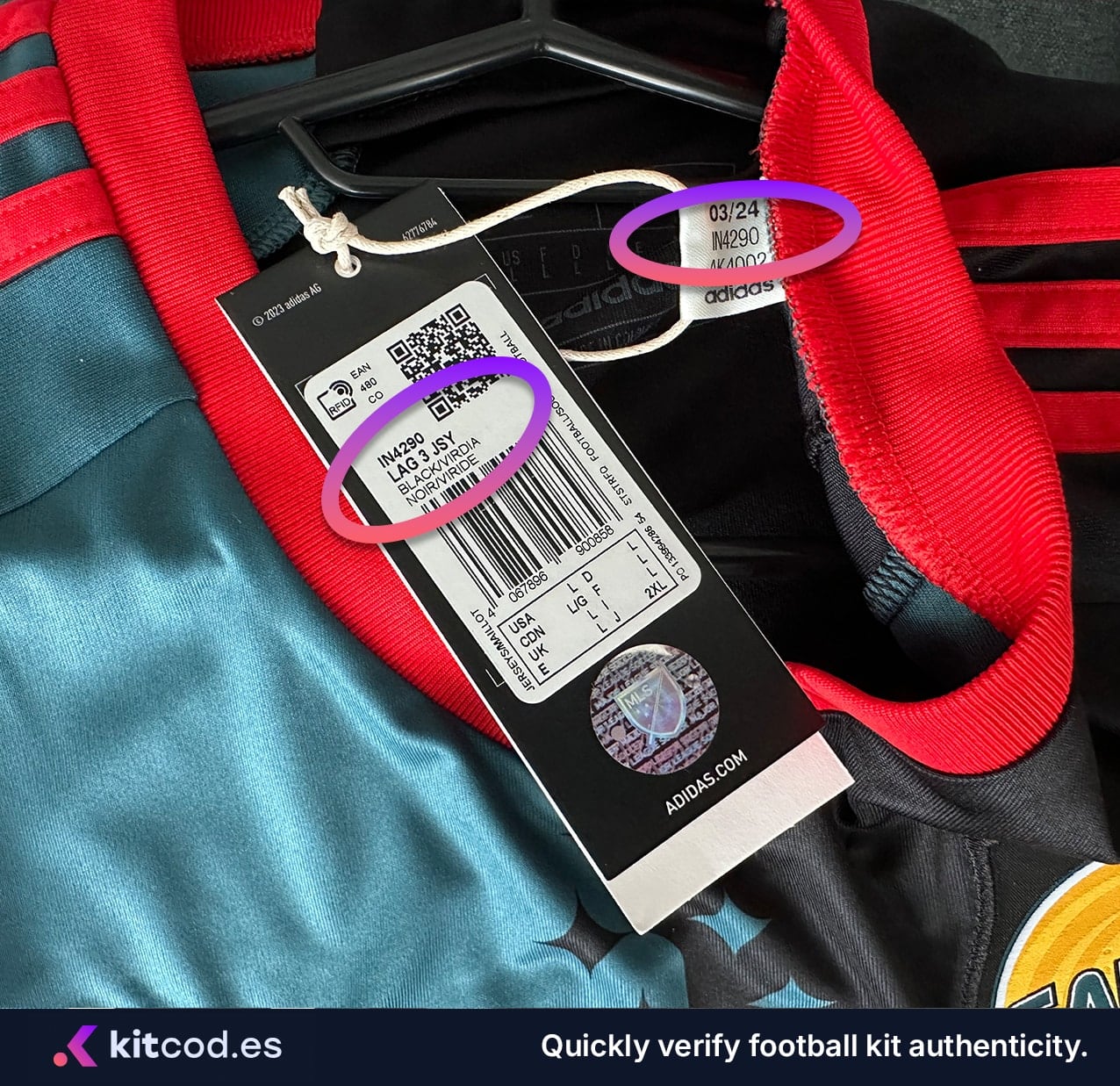
The code on the swing tag should match the one found on the smaller product code label. Any mismatch between these codes can be a sign of a fake kit. Another strong indicator of a fake is when the label fails to mention the specific kit it's for. Fake labels often use a generic term like "ADIDAS JSY", which lacks detail. In contrast, genuine labels typically reference the club name and jersey type, even if abbreviated, along with the color, which should clearly match the kit. The absence of a barcode is also a major red flag.
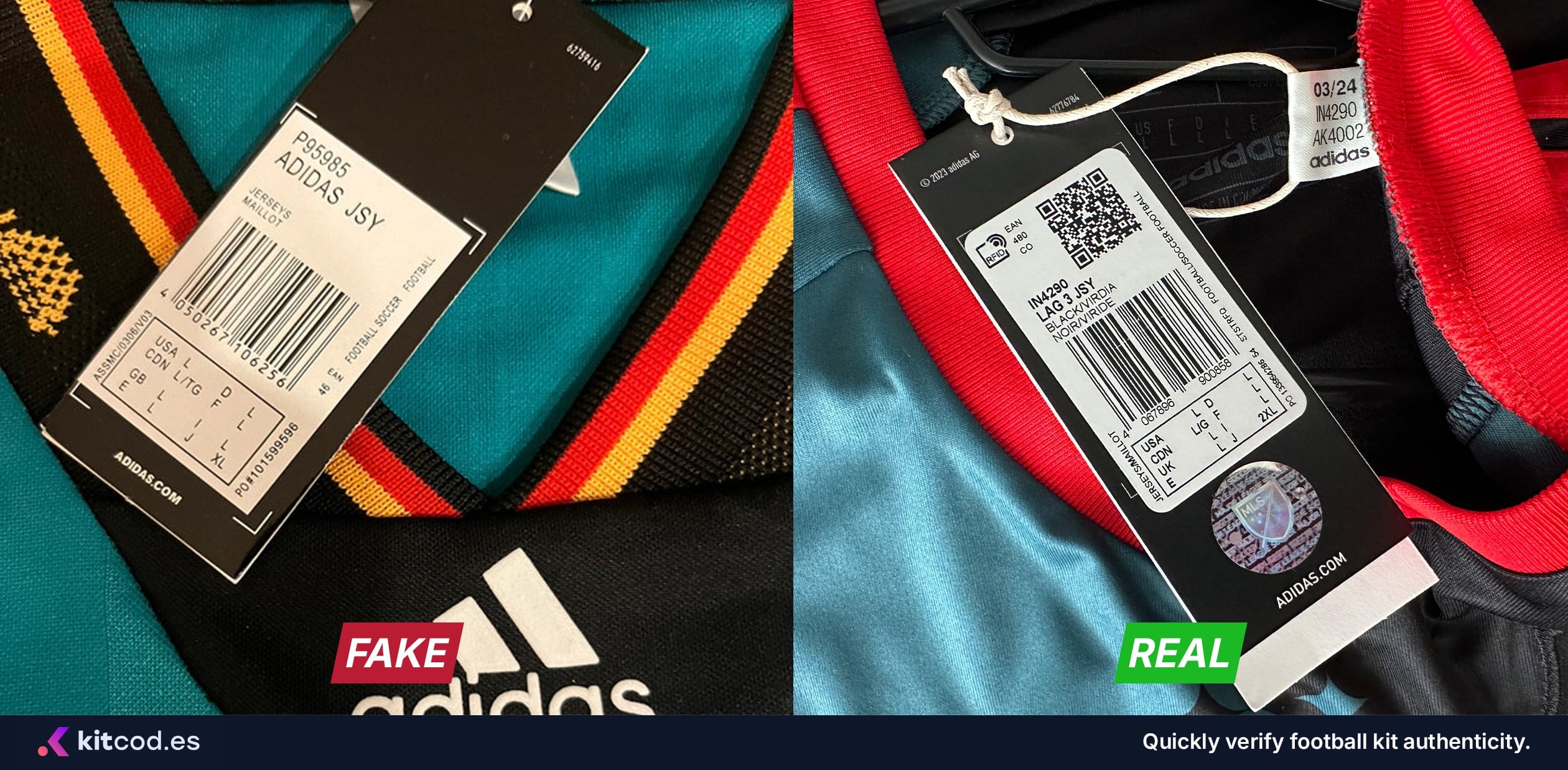
Shirt type code
Adidas swing tags often include abbreviated codes that describe the type, fit, and target audience of the shirt. These codes can be helpful when identifying whether a shirt is a player version, fan version, or intended for a specific market or demographic. Here's a quick reference guide to help decode them:
| Code | Meaning |
|---|---|
| H | Home |
| A | Away |
| 3 | Third |
| Y | Youth |
| AU | Authentic |
| L | Long Sleeve |
| P | Player |
| PL | Player Long Sleeve |
| W | Woman |
| PW | Player Woman |
Plastic barbs vs. twine
Traditionally, adidas swing tags have been attached using a thin black or clear plastic barb. However, starting around 2021, adidas began using twine on their newer releases. This twine is often beige or off-white and gives the tag a more eco-friendly, recycled look. If you're verifying a recent kit, spotting plastic instead of twine is a very common red flag, but on older shirts, plastic barbs were the norm.
The care labels
Adidas kits include a care label sewn into the inner side seam, usually near the waist area. While its main purpose is to provide washing instructions, it's also a valuable detail for authenticating a shirt.
What to look out for:
- Typos, poor spacing, or grammatical errors can be common on fake kits
- Mismatched manufacturing info - The country listed here should match the one on the neck label.
- Pen marks or scribbles - These may appear on player-spec kits, but can also indicate tampering if found on retail versions.
- Missing country of manufacture - Legally required and must always be present.
Always try to compare the care label's layout, language, and formatting to a known authentic shirt from the same season. This is often where counterfeiters make small but revealing mistakes.
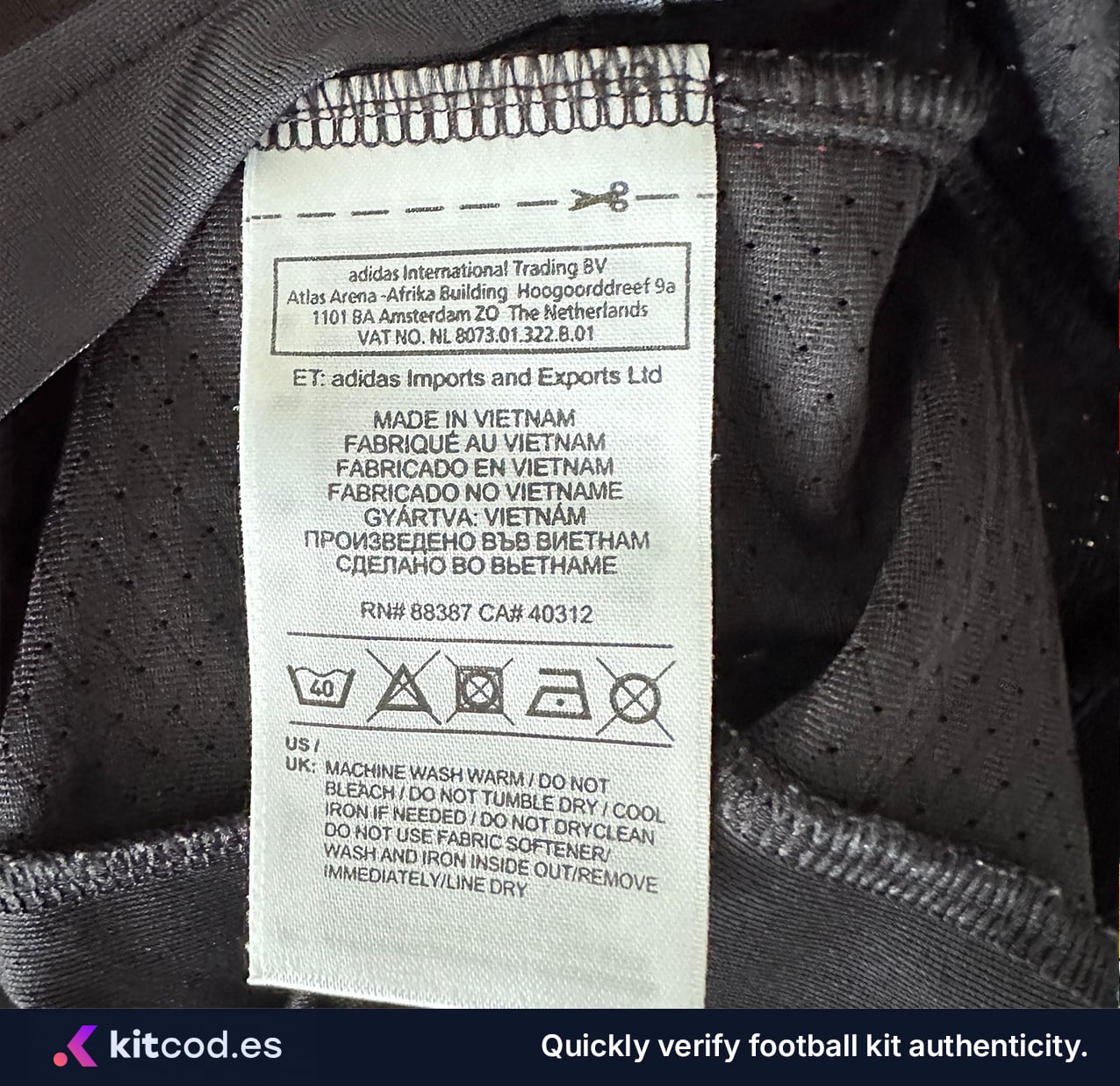
The neck label
The neck label or size print inside the collar is a key detail when verifying the authenticity of an adidas football kit. It typically features details such as the kit size across different regions, the kit technology being used, and a manufacturing country.
Made in ...
The manufacturing country printed on the neck label should always match the one listed on the wash tags inside the jersey. For example, if the neck label says "Made in Cambodia", the inner care/wash tag should say the same. Inconsistencies between these two locations are a common red flag for counterfeit kits. While adidas manufactures kits in several countries (e.g., Colombia, Vietnam, Cambodia, Mexico), the labeling should always be consistent throughout the kit.
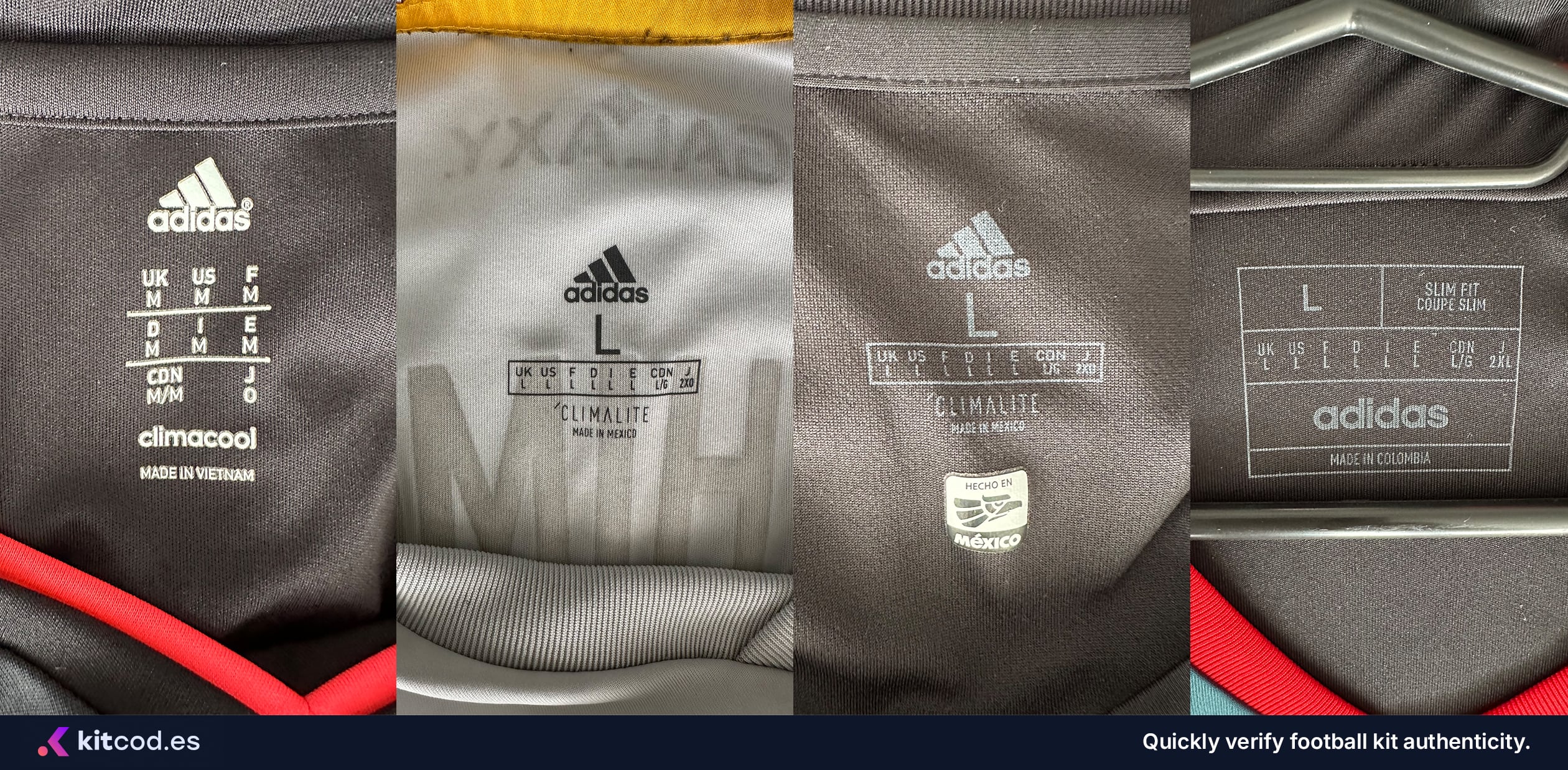
Size information
This size conversion chart shows how kit sizes align across different regions. When verifying a kit's authenticity, the size listed in the neck label should match the corresponding value on the wash tags inside the kit. Pay close attention to the Japanese size (J), counterfeit kits often get this wrong, either by mismatching it with the other sizes or using unrealistic codes (e.g., "J: S" for a US L).
| UK | US | F | D | I | E | CDN | J |
|---|---|---|---|---|---|---|---|
| S | S | S | S | S | S | S/P | M |
| M | M | M | M | M | M | M | O |
| L | L | L | L | L | L | L/G | 2XO |
| XL | XL | XL | XL | XL | XL | XL/TG | 3XO |
| XXL | XXL | XXL | XXL | XXL | XXL | XXL/TTG | 4XO |
In more recent adidas releases you might notice a shift in how Japanese sizing is displayed. Traditionally, adidas used the letter "O" (a common sizing convention in Japan) to indicate a large size. However, newer kits increasingly use "L" instead of "O" to align more closely with Western sizing conventions. This change doesn't indicate a fake but is something to be aware of when comparing older and newer kits.
The security tag
Unlike Nike, which has used security tags prominently as part of their kit authentication approach, adidas has been less consistent in using them across their football shirts. On most recent releases you will typically see the kit technology (such as AEROREADY, Climacool etc.) heatpressed on where a security tag would go.
Some adidas kits include a small rectangular authenticity patch near the bottom hem of the shirt. These can feature elements like a hologram, serial code, or simply a woven label with the adidas logo and sizing. However, this isn't universal. Many club kits, particularly earlier or lower-tier versions, may not include any such tag at all.
Adidas also varies their use of these patches based on kit tier. For example, authentic shirts (HEAT.RDY) sometimes include a minimal, heat-transferred authentication patch, while replica versions (AEROREADY) might lack one entirely or use a more generic woven tag.
Because of this inconsistency, the absence of a security tag on an adidas kit isn't necessarily a red flag, but if a tag is present, it should be well-aligned, high-quality, and appropriate for the kit type and season. As always, comparing with known authentic examples from the same release is a good way to verify.
Design details
Over the years, adidas has used a variety of security tag styles. Some have subtle holographic details, while others are either sewn on or heat-pressed onto the fabric. These tags are most common on first-team kits, but there are exceptions, especially with training shirts or kits from smaller clubs, where a security tag may be missing entirely.
Notable exceptions
- Between roughly 2013 and 2018, security tags were noticeably less common on kits.
- Kits made before 2006 often don't feature a security tag at all. Instead, they may have a club-branded patch sewn onto it.
Timeline
The graphic below outlines the different security tag styles adidas has used, along with an approximate timeline of when each was introduced. You can read each year as the starting point for that tag style, with the previous version being phased out around the same time.
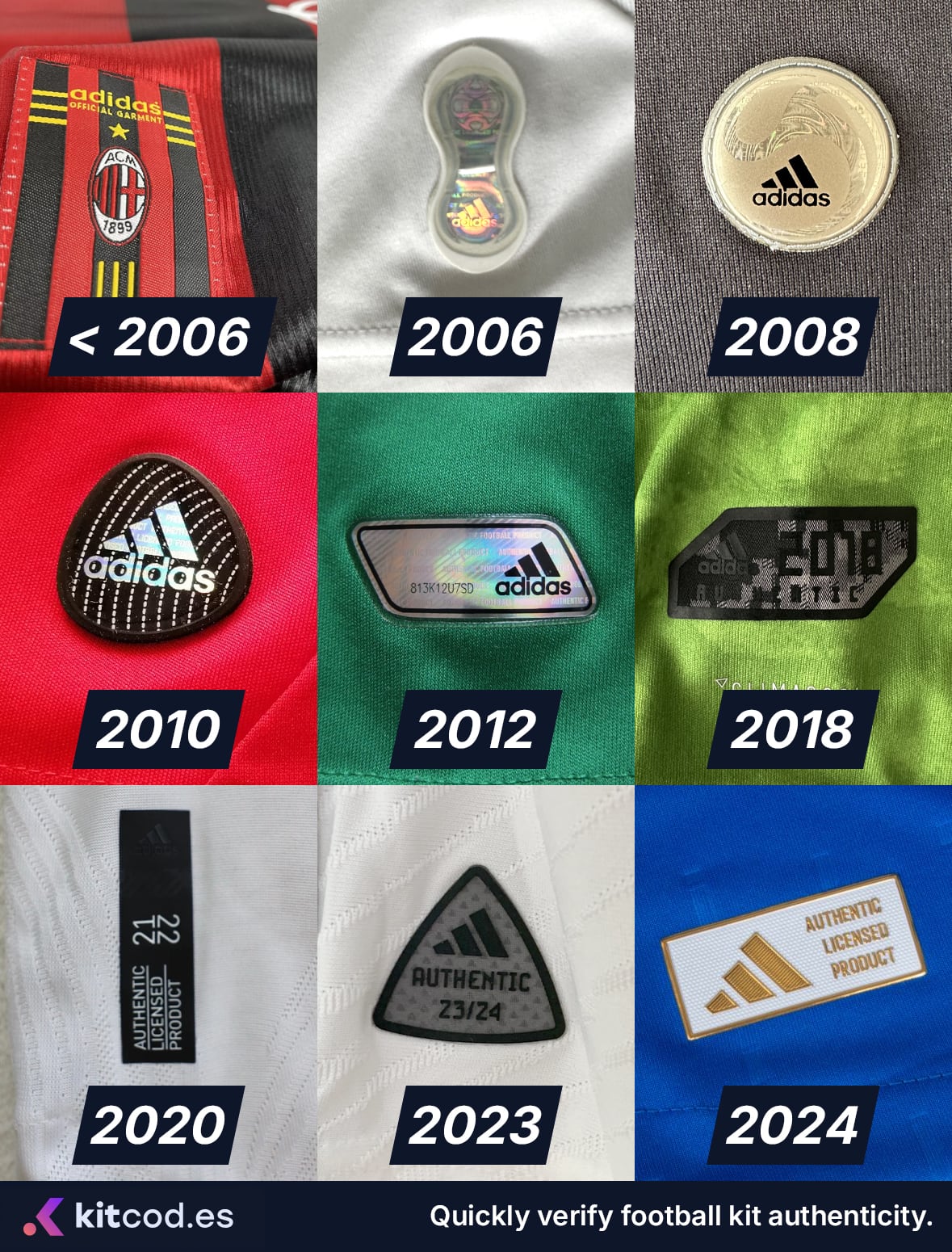
Logos, crests, and stitching
The club crest is one of the most noticeable and telling details on a football kit, and a common giveaway on counterfeit adidas kits. While fake kits often get the general shape right, they frequently miss the finer details that set real adidas embroidery or heat-transfers apart.
The adidas logo
The adidas logo is one of the most recognized sports emblems in the world. Since its widespread adoption in the late 1990s, the three-stripe mountain design paired with the lowercase "adidas" wordmark has been the standard logo on most football shirts. While the classic trefoil logo is still used occasionally for retro-inspired releases, it's the modern version that appears on the vast majority of kits post-2000.
On genuine shirts, whether replica or player-issue, the logo is clean and well-executed. Embroidered versions should have tidy stitching, straight lines, no loose threads, and a balanced shape. Heat-applied logos should sit flush with the fabric and not peel or bubble. The wordmark should line up with the bottom of the three stripes, and the spacing between letters (kerning) should look consistent. It's often these small visual details that set the real thing apart.
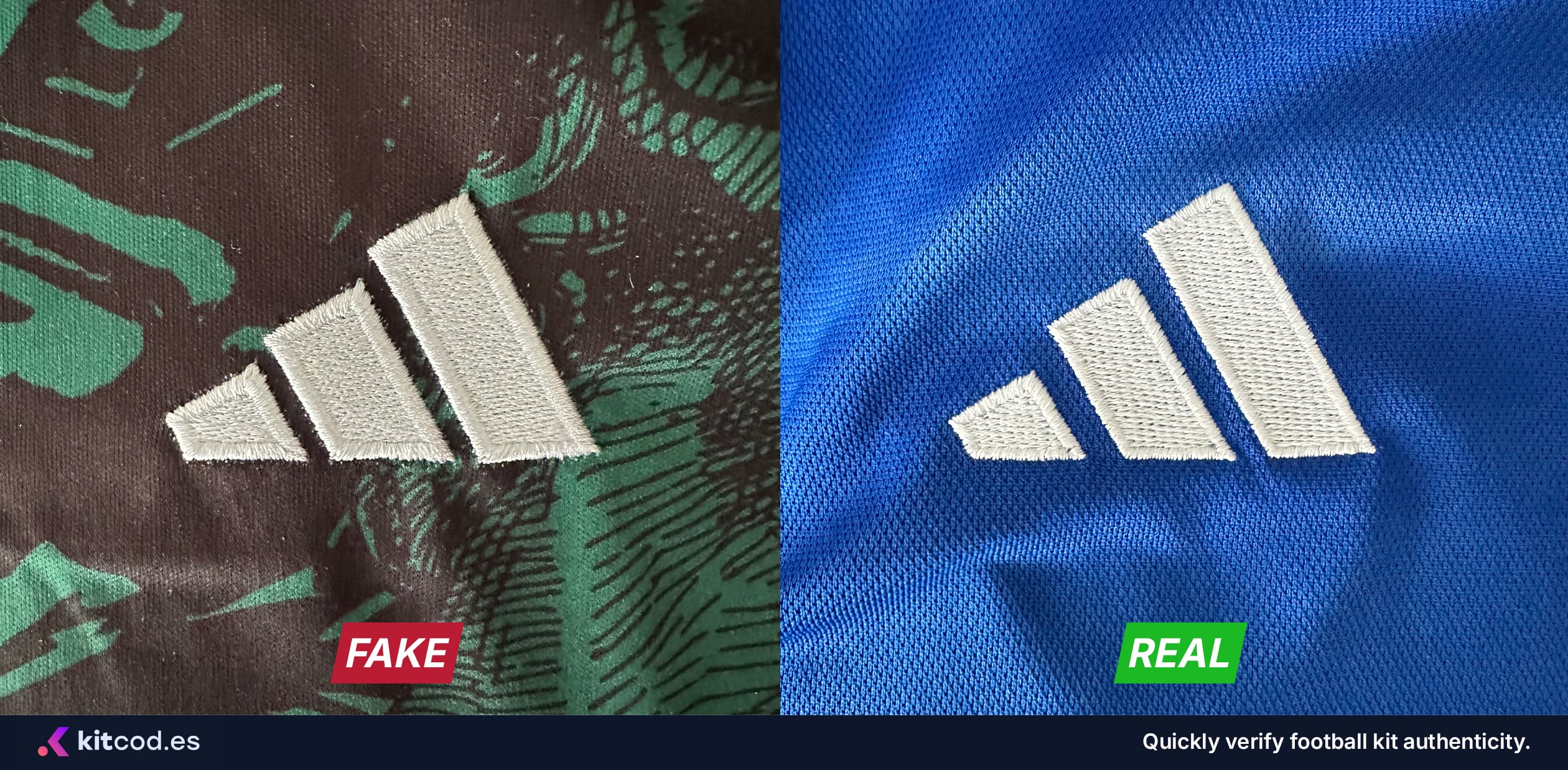
Fake shirts often get the logo wrong in obvious ways. Stitching might be messy, with stray threads or uneven alignment. The typeface can be too thin or distorted, and the three stripes might appear crooked or spaced incorrectly. Sometimes the letters of the wordmark connect awkwardly with the stripes, or the logo causes puckering in the shirt fabric. All of these are telltale signs that the shirt wasn't made to adidas' standards.
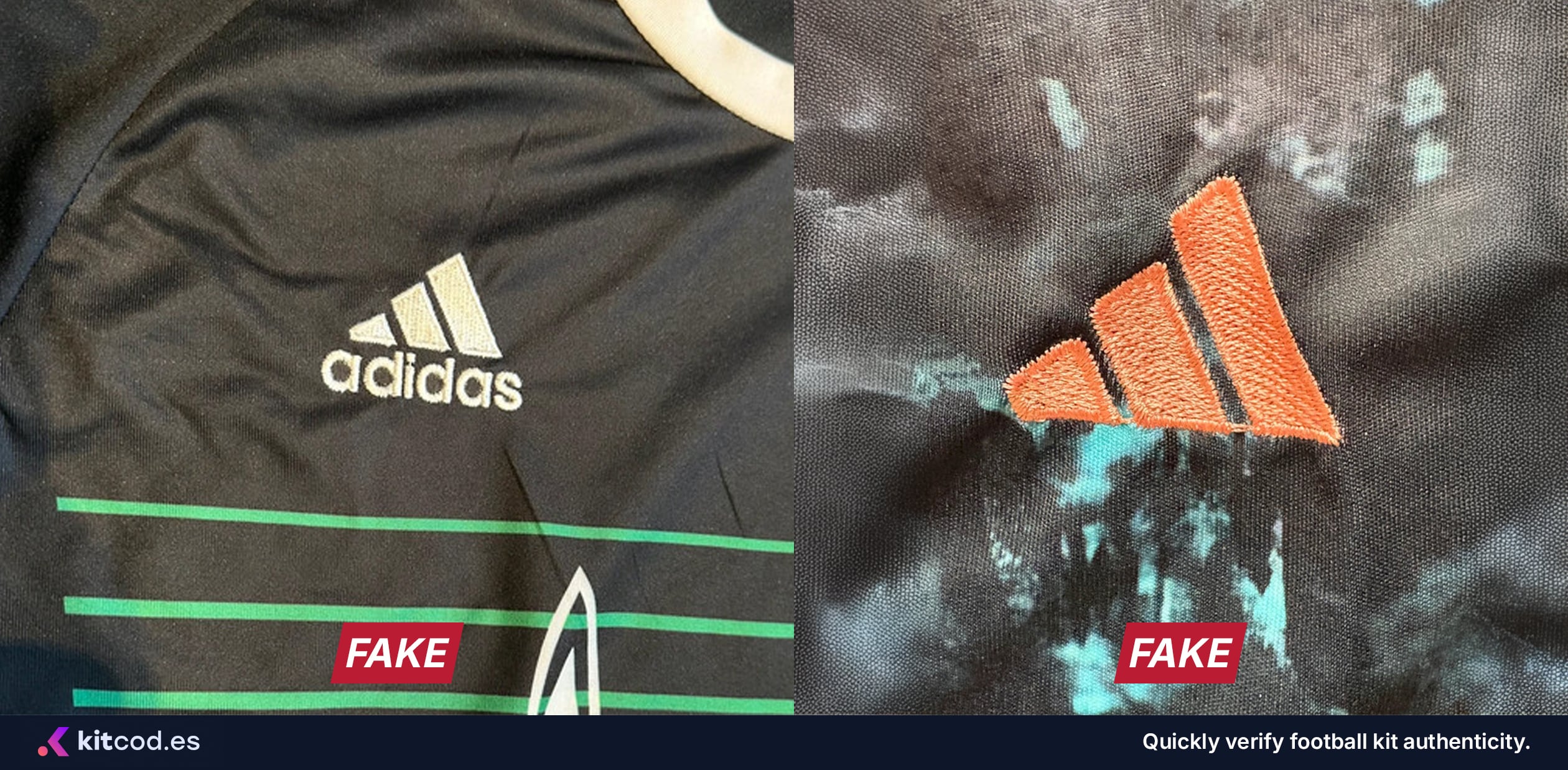
On authentic kits, the adidas wordmark should sit neatly against the three stripes, forming a single cohesive logo. A common red flag on fakes is when loose threads connect the letters, which usually points to poor-quality stitching. Another giveaway is when the stripes end in droopy or tapered tails, rather than clean, straight edges.
Pro tip
Compare the listing with official product photos or verified examples from trusted sources. Even minor differences in spacing, stitch density, or the finish of the crest can be enough to spot a fake.
RN56323 and CA40312
The numbers RN88387 and CA40312 are registration numbers that appear on many adidas garments, including football kits. These codes are not unique to individual items or specific products, instead, they are broad identifiers registered with U.S. and Canadian authorities. RN56323 is adidas' U.S. Registered Identification Number (RN), and CA40312 is their Canadian equivalent.
These numbers simply confirm that adidas is the manufacturer, but they are printed on virtually every adidas garment, regardless of style, year, or category. As such, they cannot be used to verify authenticity or date a kit, and they often appear on fake kits as well. While it's good to know what they are, they offer little value when it comes to actual authentication.